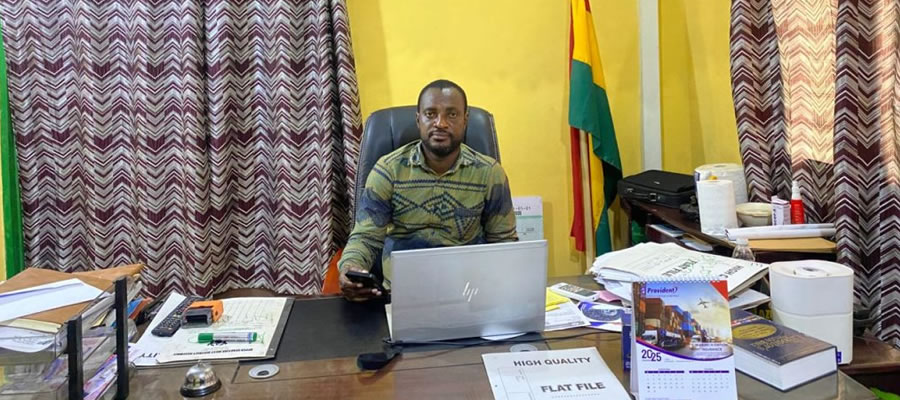

The Health facilities in the Municipality include the following:-
One (1) Hospital at Dunkwa-On-Offin
One (1) Private Hospital at Dunkwa-On-Offin
Twelve (12) community clinics at:
• Imbraim Amoafo
• Buabin Kramokrom
• Danyase Asikuma
• Agyempoma Abudukrom
• Praprababida Asma Camp
• Zion Camp Buabinso
Three (3) Health Centres at:-
• Kyekyewere
• Oponso
• Pokukrom
The health of the population of the District is basic pre-requisite for its development. In view of this the analysis on health considers variables such as the availability of health facilities, adequancy of health personnel, top ten diseases and immunization coverage. Health delivery system in the District is made up of the orthodox and traditional system. The latter is made up of herbalists, fetish priest and spiritualist. The Traditional system though plays a crucial role in health delivery in the District, is underdeveloped. It has not been in any way integrated into the modern or orthodox medical practice
Health delivery under the orthodox system in the District exists up to the Level C under the countries primary health care system with a district Hospital offering a referral services. Thus is under the management of the District Health Management Team.
Health Facilities
The Health facilities in the District include the following:-
One (1) Hospital at Dunkwa-On-Offin
One (1) Private Hospital at Dunkwa-On-Offin
Five (5) community clinics at:
• Imbraim
• Nkotumso
• Ntom
• Buabin
• Agyempoma
Five (5) Flealth Centres at:-
• Kyekyewere
• Oponso
• Diaso
• Subin
• Ayanfuri
One (1) Primate Maternity Home at Dunkwa-On-Offin
• Twenty-five (25) trained Traditional Birth Attendance
Health Personnel
The key personnel in the District’s health delivery system include two (2) Medical Officers, three (3) Cuban doctors, one (1) Dental Surgeon, One (1) Pharmacist and others.
The number of the various categories of health personnel in the District is inadequate. For instance, the Doctor - Patient ratio of 1 -.20,053 and nurse-patient ratio of 1:2560 puts too much burden on doctors and nurse. These high ratios coupled with inadequate logistical support could have negative impacts on the health delivery system in the District.
Top Ten Diseases and Reported Cases
The first ten most frequently occurring diseases in the District are Malaria, Typhoid Fever and Dental caries have been most common diseases in the District over the years with malaria leading the list followed by Typhoid fever. Malaria does not only lead the list, but also its proportionate share of the overall total reported cases of the top ten diseases has been increasing, For instance, in 2003, the reported cases were 6204 but this increased to 8004 and 8463 in 2004 and 2005 respectively.The position of malaria among the Top Ten Diseases conformity with the Regional and National trends. It is an indication of poor environmental quality such as the presence of stagnant waters and unkept surroundings within settlements.
HIV/AIDS
One hundred and fifty (150) cases of HIV/AIDS were reported in 2003, 114 cases in 2004 and 202 in 2005. In view of its deadly nature and its socio-economic implications for the development of the District, programmatic effects need to be put in place to curb its spread. Efforts being made in this direction include the following:-
Preparation of District HIV/AIDS Strategic Plan.
Community - Based Organization and Non-Governmental organizations have been accessing funds from the Ghana Aids Commission to implement various HIV/AIDS educational campaigns and other programmes.
Provision of Care and Support of PLWHAS by NGOs
Summary of Health Problems and Current Interventions Problems that affect health delivery in the District include:-
Inadequate Health Personnel
Uneven distribution of health facilities in the district
Inadequate transport for health related activities
Inadequate staff accommodation
Efforts are being made to open CHPS compounds at Amoaman, Asma Camp and Nkwantanum.
Mutual Health Insurance Scheme
The scheme is progressing steadily in the District. The scheme has so far registered 28,448 members as per details below:
70years plus - 5,270
Under 18 years - 11,580
SSNIT Pensioners - 1,265
Indigents - 425
SSNIT Contributors - 517
Fully paid-up member- 4,738
Total 28,448
As at the end of June, 2006, a total premium of 898,238,667 had been received made up of:
Informal Sector - 338,052,000
Refund for exempt - 510,206,667
Total - 898,258,667
Environmental Situation on health Water
Despite the various efforts to provide potable water for rural communities, access to potable water is a major problem in several communities in the District. About a total of 45% of the district population has no access to potable water. The major sources of drinking water in the District include the following:-
Mechanised boreholes
Rivers
Steams
Hand dug wells
Currently, there are about 187 boreholes spread throughout the District with about 155 of them functioning as shown in table Some of these boreholes are not functioning because of any of the following reasons.
High population pressures being exerted on the facility.
Inability of the communities to raise funds to rehabilitate them as the management of the boreholes is in the hands of the communities (water points committee’s).Consequently, the communities concerned have been compelled to drink from steams and rivers. Whilst some of these rivers or steams dry up during the dry season, others have been rendered unsuitable for human consumption as a result of illegal mining operations in the District. There are still many settlements, especially the newly emerging ones without any proper source of potable water.
With the exception of Dunkwa, the District capital, Diaso and Nkotumso, are all served with mechanized boreholes system, through pipelines. Water services in Dunkwa, the District Capital is managed by Ghana Water Company Limited. Water consumption level for the town is 13637m2 per hour, which is supplied by 5 boreholes in pipelines to customers. About 80% of the township has access to potable water except those newly developed areas such as Burger’s Estate etc.The company currently supplies about 540 customers (ie private connections) in the town with 20 standpipes. This is inadequate considering the high volume of water that can be produced by the 5 boreholes. There have not been much public complaints about the services provided, as water supply in general is good in the town. The Ghana Water Company Limited has earmarked the following activities within this plan period:
Sanitation
As part of the efforts to attain its goal, the Assembly seeks to improve sanitation and waste management in the district. The Assembly’s main focus is on the areas of public latrines (KVIP, VIP) Institutional and household. It is also the aim of the Assembly to totally phase out the use of pan latrines in the district. In this regard the Assembly has been working hard to provide places of convenience to the public and institutions, and also encouraging landlords to put domestic toilet facilities in their houses.
Liquid Waste Disposal
Pit latrines and the Mozambique pit latrines are mostly found in the rural communities and a few bigger communities (Zonal Capitals) in the district. The pan latrines (being phase out) are mainly found in private homes. In absolute terms, however, household toilet facilities in the district are very few considering the number of houses and for that matter, the population. The reality is that, the majority of the population relies on the few public communal toilets and the pressure on the facility reduces their life span.
Indiscriminate disposal of liquid waste are common scenes especially in the outskirts of the towns and this poses serious health menace. The district has only two (crude) final disposal sites. It has recently acquired a vast stretch of land at Babianeha to be developed into final disposal site under the Urban V Projects. The Assembly has also taken a delivery of Cesspool Emptier for dislodging.
Liquid Waste Management Facilities
No of public toilets in the district 25
No. of Public W/C facilities 8 (8 in (Dunkwa)
No. of Public Aqua privy latrines 17
No. of institutional latrines 68
No. of premises with toilet facility except pan latrines in the district..680
Volume of liquid waste dislodged and transported to final disposal site per day
5,000 cubic litres
Treatment of liquid waste Nil
Method proposed for treatment Oxidation
Ponds (i.e Mechanical or Biological
Solid Waste Management
Solid waste management is not yet a key development problem especially in the rural environment as almost all communities have two or more organized waste disposal sites where domestic waste are finally dumped. The management of these sites is rather poor as decomposed refuse keeps on accumulating daily resulting in heaps of refuse. This poses serious health threats.
However, the story is deferent at Dunkwa, the district capital where about a quarter of the population reside. There are only 7 - controlled waste disposal sites. While these are not adequate, are not strategically distributed in town. This is evidenced by the existence of numerous uncontrolled and indiscriminate disposal of solid waste in the township.The sanitation problem is further compounded by the absence of the containers at strategic locations and temporary dumpsites and the poor state of the Assembly’s refuse truck. Although an attempt is made by scavengers to rake and burn refuse deposited indiscriminately, partially burnt or decomposed refuse keeps on accumulating daily resulting in hillocks at some locations such as Brumase, Obratwawuo, Mfuom, Osofoakurase, Kadadwen etc.
Solid Waste Management Facilities
No. of collection sites 17 (only Dunkwa)
No. of crude dumping sites 160
Volume of refuse generated, transported and managed per day 260 tons.
Treatment of Solid Waste Nil.
Method proposed for treatment Land fill.
Size of final disposal site acquired 25km2.
Drainage
The Assembly lacks well constructed drainage system. Most of the drains are silted. Periodically some parts of Dunkwa become flooded and sometimes rivers overflow their banks, rendering some communities, which are low lying inaccessible. Drains to channel domestic effluent are inadequate in most communities in the district. Stagnant and pools of dirty water around dwelling units are common scenes in the district.
This is the result of improvised detached kitchen and bathrooms without any proper drains. The pool of water also serves as fertile breeding grounds for mosquitoes. Poor drainage system has also contributed to erosion problem in the district. In view of the poor drainage system, storm water has eroded streets, foundations of most building creating gullies, which pose serious threat to both life and property. The Assembly has taken serious view of the poor drainage system in the district.
Date Created : 11/27/2017 4:44:50 AM










 facebook
facebook
 twitter
twitter
 Youtube
Youtube
 +233 593 831 280
+233 593 831 280 0800 430 430
0800 430 430 GPS: GE-231-4383
GPS: GE-231-4383 info@ghanadistricts.com
info@ghanadistricts.com Box GP1044, Accra, Ghana
Box GP1044, Accra, Ghana